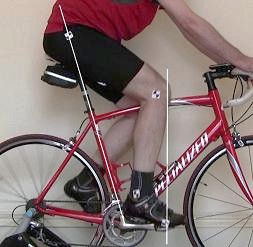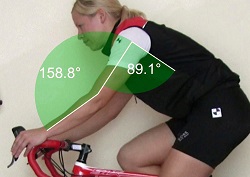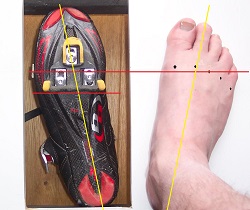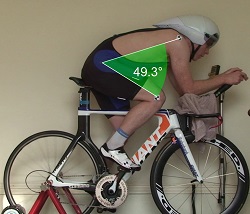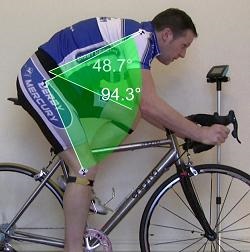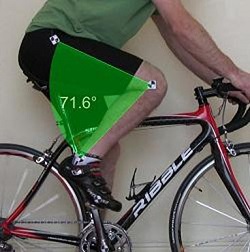The ideal saddle height can be described by the angle of the knee at full extension. Typically, men will be close to 141° and women maybe 1-2° higher. The difference is due to flexibility, with looser female hamstrings allowing the knee to extend further. Tight hamstrings will inhibit the extension of the knee, so many people find that being less than 140° may suit them better. Just using knee angles to set saddle height can be problematical, which is why at BikeDynamics we use at least 10 separate pieces of information to establish an appropriate position. These include knee minimum angles, ankle postures, hip movement and injury history.
Bike Fitting Guidelines
The simplest method for establishing saddle fore aft position is to hang a plumb line from the tibial tuberosity (the bony bump below your kneecap). This should pass straight through the pedal spindle when the crank arm is at three o'clock. This is called the Knee Over Pedal Spindle (KOPS) rule, but contrary to popular opinion there is absolutely no biomechanical justification for it. In fact, if the saddle height is incorrect the knee will be too far forwards or back and it will be wrong!
It can work very well though because it is a good predictor of the hip position relative to the seat tube axis. If the hip joint is along this axis, the rider will tend to be well balanced without too much weight on their hands and as the bike designer intended. Finding the precise point on the Greater Trochanter to signify the hip centre of rotation can be tricky though, which is why the KOPS technique is more popular.
Contrary to some perceived wisdom, your crank lengths should be proportional to leg length and in our opinion are the third most important bike fit parameter after height and set back. This is especially the case if the rider is relatively short. Various studies have shown little downside to short cranks, whereas if they are too long, the range of motion required at the hip, knee and ankle joints can become excessive, causing injuries, inhibiting the ability to 'spin' and compromising optimum muscle contraction rates.
With the saddle correctly set, the horizontal and vertical distances to the handlebars are key to aerodynamics, efficiency and comfort. The torso angle to the horizontal will typically be 40° to 50°, ranging from quite aggressive to relatively relaxed. The hands should fall naturally onto the hoods, with a soft bend at the elbows and relaxed shoulders. This will typically give an upper arm to torso angle of 85° to 90°. The hoods should be adjusted to give a neutral wrist posture (as if handshaking). The drops need to be high enough to be accessible, preferably on flats as well as descents.
The cleats should be positioned such that the ball of the foot is over the pedal spindle and to accommodate the natural toe in or out of the foot. The ball of the foot can be defined as the end of the metatarsal bones which can be found with a bit of light prodding. Alternatively just use the bony lump on the inside of the foot at the base of the big toe. There is little downside to cleats being too far back and numerous problems if forwards, so if in doubt, move the cleats back.
Time Trial and Triathlon bike positioning is a fascinating subject, requiring a precise blend of biomechanics and aerodynamics to support the often highly competitive aspirations of the cyclist. These two factors can be both complementary and contradictory in the position they require the rider to adopt and can have a significant effect on the performance and comfort during a Time Trial or Triathlon.
Before anybody shouts, I know these rings are not necessarily 'oval' but you know what I mean, rings that change their diameter and so give different gear ratios at different crank arm positions. Read here for our view on their effectiveness.
Very few cyclists will adopt a single riding position for all of their time on the bike. At the very least people will regularly change their hand positions and generally shuffle about to ease pressure points. This section aims to explore some of the more usual postural changes that people adopt when cycling.
The bike fitting process is enhanced by understanding the muscle groups active around the pedal stroke. Read here to understand the primary contributions from the Quads, Glutes, Hamstrings and Calves.
You may be interested in our new 45 Page PDF download describing all the observations, simple measurements and calculations required to do your own Dynamic Bike Fits.


